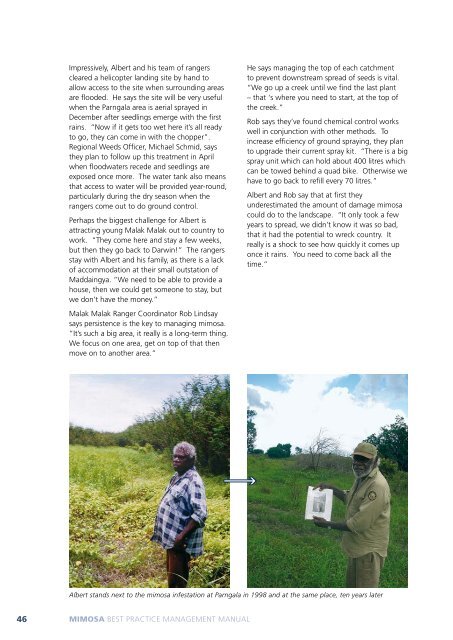Chapter 4. Case studies - Department of Land Resource ...
Chapter 4. Case studies - Department of Land Resource ...
Chapter 4. Case studies - Department of Land Resource ...
- No tags were found...
You also want an ePaper? Increase the reach of your titles
YUMPU automatically turns print PDFs into web optimized ePapers that Google loves.
Impressively, Albert and his team <strong>of</strong> rangerscleared a helicopter landing site by hand toallow access to the site when surrounding areasare flooded. He says the site will be very usefulwhen the Parngala area is aerial sprayed inDecember after seedlings emerge with the firstrains. “Now if it gets too wet here it’s all readyto go, they can come in with the chopper”.Regional Weeds Officer, Michael Schmid, saysthey plan to follow up this treatment in Aprilwhen floodwaters recede and seedlings areexposed once more. The water tank also meansthat access to water will be provided year-round,particularly during the dry season when therangers come out to do ground control.Perhaps the biggest challenge for Albert isattracting young Malak Malak out to country towork. “They come here and stay a few weeks,but then they go back to Darwin!” The rangersstay with Albert and his family, as there is a lack<strong>of</strong> accommodation at their small outstation <strong>of</strong>Maddaingya. “We need to be able to provide ahouse, then we could get someone to stay, butwe don’t have the money.”Malak Malak Ranger Coordinator Rob Lindsaysays persistence is the key to managing mimosa.“It’s such a big area, it really is a long-term thing.We focus on one area, get on top <strong>of</strong> that thenmove on to another area.”He says managing the top <strong>of</strong> each catchmentto prevent downstream spread <strong>of</strong> seeds is vital.“We go up a creek until we find the last plant– that ‘s where you need to start, at the top <strong>of</strong>the creek.”Rob says they’ve found chemical control workswell in conjunction with other methods. Toincrease efficiency <strong>of</strong> ground spraying, they planto upgrade their current spray kit. “There is a bigspray unit which can hold about 400 litres whichcan be towed behind a quad bike. Otherwise wehave to go back to refill every 70 litres.”Albert and Rob say that at first theyunderestimated the amount <strong>of</strong> damage mimosacould do to the landscape. “It only took a fewyears to spread, we didn’t know it was so bad,that it had the potential to wreck country. Itreally is a shock to see how quickly it comes uponce it rains. You need to come back all thetime.”Albert stands next to the mimosa infestation at Parngala in 1998 and at the same place, ten years later46 MIMOSA BEST PRACTICE MANAGEMENT MANUAL
















